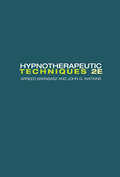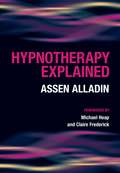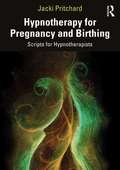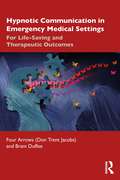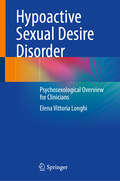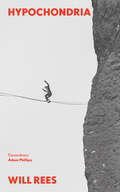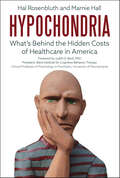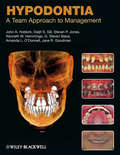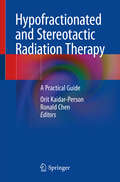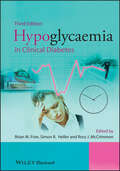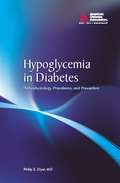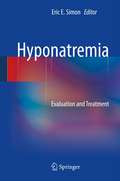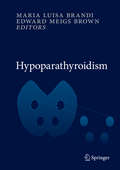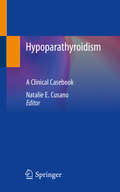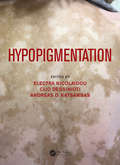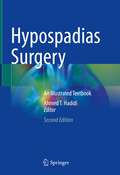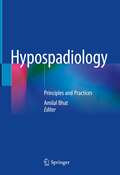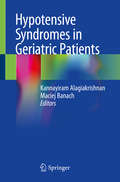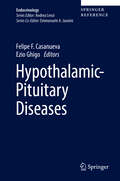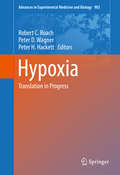- Table View
- List View
Hypnotherapeutic Techniques: Second Edition
by John G. Watkins Arreed BarabaszTwo premier hypnotherapists collaborate on a new edition of this award-winning text, a collection of techniques and information about hypnosis that no serious student or practitioner should be without. A thorough and practical handbook of various hypnotherapeutic measures, it contains illustrative examples and logically argued selection methods to help practitioners choose the ideal method for a needed purpose. Section by section, it breaks out the various methods and phenomena of hypnosis into easily digested chunks, so the reader can pick and choose at leisure. An excellent practical guide and reference that is sure to be used regularly. The authors have a wide and longstanding experience on the subject and thus can stay on clinically approvable methods.
Hypnotherapy
by Dave ElmanClassic work by a professional hypnotist who, for many years, taught physicians and other professionals the use of hypnosis.
Hypnotherapy Explained
by Assen Alladin Glenn RobertHypnotherapy provides a powerful tool for utilizing the power of the mind to reduce distress and suffering. This concise guide provides readers with a rich source of ideas on starting hypnotherapy practice, and thinking seriously about hypnosis as a powerful adjunct to psychotherapy and medical interventions. With a clear definition of what hypnosis really is, readers can develop an understanding of the rationale for utilising hypnotherapy with particular disorders.As the medical community is progressively adopting a biopsychosocial model of healing, there is a serious move toward validating the scientific credibility of hypnosis, and hypnotherapy has become a well-established treatment. Unlike any other introductory text, "Hypnotherapy Explained" adopts a uniquely scientific approach among introductory texts; reviewing theories and offering practical ways to integrate hypnotherapy in medical, psychiatric and psychotherapeutic practice. It is enlightening reading for general practitioners, psychiatrists, psychologists and other healthcare professionals.
Hypnotherapy for Pregnancy and Birthing: Scripts for Hypnotherapists
by Jacki PritchardThis practical volume provides resources and guidance for practising hypnotherapy with pregnant women and their birthing partners. Hypnotherapy for Pregnancy and Birthing begins with an overview of the topic and discusses a range of complex issues and vulnerabilities that might arise during sessions, before moving onto setting up and running group and/or individual sessions. Then, presenting techniques to work with pregnancy and birthing draws on a range of methodologies including solution-focused, metaphors (Ericksonian), Gestalt therapy, benefits approach and regression therapy. It covers: • Hypnosis, pregnancy and birthing • Getting into trance and relaxation • Breathing • Practising self-hypnosis and working on issues • Preparing for birthing • Bonding with baby • Working with worries, fears and phobias • Dealing with trauma and the unexpected • Loss and bereavement • Ego boosting. Containing over 70 customisable scripts and designed to stimulate reflection, this book is a valuable resource for student, newly qualified and experienced hypnotherapists working with pregnancy and birthing.
Hypnotic Communication in Emergency Medical Settings: For Life-Saving and Therapeutic Outcomes
by Don Trent Jacobs (Four Arrows) Bram DuffeeThis fascinating book demonstrates how hypnotic communication has the potential to improve patient outcomes in emergency care, integrating insights on the connection between mind and body for paramedics and other first responders. Providing a step-by-step guide to using these skills around a range of contexts, from managing pain to cardiovascular emergencies to burns to respiratory distress, the book asks paramedics and first responders to become aware of what they say to patients, as well as how they say it. It offers ways to allow targeted communication to complement standard medical procedures, creating a symbiotic rapport that will provide the basis for an improved outcome for the patient. Fully referenced and based on a robust range of evidence, the book is written by an active paramedic with over 20 years’ experience with a Ph.D. in Human Development with a focus on paramedic decision-making; and a professor with doctorates in Health Psychology and Education who field tested the skills as a professional EMT. This book will interest any professional working in emergency care, including paramedics, EMTs, trauma nurses, and psychiatric nurses.
Hypoactive Sexual Desire Disorder: Psychosexological Overview for Clinicians
by Elena Vittoria LonghiThis book provides a thorough review of scientific research on sexual desire disorders. Offering a comprehensive overview, it delves into the pathological, social, and relational factors influencing various manifestations of these disorders. This book aims to illuminate the complexities of Hypoactive Sexual Desire Disorder (HSDD) and broaden the understanding of its variants, including hypersexuality, asexuality, and reluctance to manage sexual desire. Endocrinologists, gynecologists, and andrologists will benefit from this book which integrates cutting-edge research with practical clinical insights, providing readers with an overview needed to improve their confidence and compassion in navigating and managing the multifaceted nature of sexual desire disorders.
Hypochondria
by Will ReesA personal and literary examination of hypochondria.A free-wheeling philosophical essay, Hypochondria is expansive in its range of references, from the writings of Franz Kafka to original yet accessible readings of theorists like Lauren Berlant. Whether he is discussing Seinfeld, John Donne, or his own hypochondriac past, Rees reveals himself to be a wry and perceptive critic, exploration the causes – and the costs – of our desire for certainty. With wit and erudition, Hypochondria demonstrates both the rewards and the perils of reading (too) closely the common but typically overlooked aspects of our everyday lives.
Hypochondria: What's Behind the Hidden Costs of Healthcare in America
by Hal Rosenbluth Marnie HallA hypochondriac CEO shares his journey through the broken American healthcare system, analyzing its costliness and proposing a solution.New York Times–bestselling author Hal Rosenbluth is the maverick executive behind Take Care Health Systems, the former president of Walgreens Health and Wellness and the now chairman and CEO of New Ocean Health Solutions. He is also a hypochondriac who amassed 227 medical claims in just two years. In Hypochondria: What&’s Behind the Hidden Costs of Healthcare in America, Rosenbluth and co-author Marnie Hall venture through Rosenbluth&’s 227 claims. They take a brutally honest, but humorous journey from the evolution of Rosenbluth&’s global management firm to his onset of Type 2 Diabetes, a tale woven with sleeping meds, nocturnal PB&J sandwiches, and anti-anxiety drugs; to founding a company with the youngest Johnson & Johnson president and his most recent entry to digital healthcare.Hypochondria is not just a memoir. Along the way, the authors address the broader impact that each stakeholder—health plans, providers, health systems, and big pharma—have on the nation&’s overstressed healthcare system. The book also offers a well-rounded guide to the traditional and not-so-typical solutions that can help people manage illness anxiety. Entertaining and enlightening, Hypochondria opens a new dialogue about how the U.S. can get better at managing health and arresting costs of care, which includes promoting greater discussion amongst patients, families, providers, employers, and healthcare executives. This book should serve as a beacon for change, unraveling the commercialization of healthcare, dissecting Big Pharma&’s role in America&’s pill-popping culture, and proposing alternative, disruptive solutions.
Hypodontia: A Team Approach to Management
by John A. Hobkirk Jane R. Goodman Amanda L. O'Donnell Steven P. Jones Kenneth W. Hemmings G. Steven Bassi Daljit S. GillHypodontia: A Team Approach to Management provides specialist clinicians with a practical reference to the multidisciplinary management of patients with this condition. The book synthesises current information and best practice from specialties involved in the treatment of hypodontia into one comprehensive volume, emphasising a problem-based approach throughout. This volume is structured over three sections. Part One offers background information on the epidemiology and aetiology of hypodontia, its inheritance patterns and syndromic associations, as well as describing the clinical features of the condition and outlining the importance of a multidisciplinary approach to patient care. Part Two addresses key issues in hypodontia management, namely challenges posed by excessive or inadequate space within and between the dental arches, specific occlusal considerations, and problems related to the supporting tissues. Part Three considers treatment of hypodontia within the framework of three broad stages of dental development: the primary/early fixed dentition, the late mixed dentition/early permanent dentition, and finally the established dentition. Hypodontia: A Team Approach to Management draws on the best available evidence and opinion to provide a complete, in-depth practical resource for dental specialists dealing with this complex condition. Complete multidisciplinary resource on hypodontia Authored by a team with over 30 years of clinical and research experience in the treatment of hypodontia Extensive reference lists Features comprehensive section on age-related approaches to treatment Many clinical illustrations in full colour
Hypofractionated and Stereotactic Radiation Therapy: A Practical Guide
by Orit Kaidar-Person Ronald ChenThis handbook summarizes the data and techniques for hypofractionation and stereotactic radiation in a clinically-accessible way. Hypofractionated radiation therapy, which consists of larger-dose radiation treatments that are given over a shorter time period compared to conventional radiation fraction sizes, is used to treat a variety of cancers, including prostate, breast, lung, and colorectal. Conventional radiation therapy and hypofractionated radiation therapy have different effectiveness rates for cancer treatment and have different impacts on normal tissues in terms of causing toxicity. There is a significant and growing body of literature on the use of different dosing regimens to treat a variety of cancers and radiation oncologists need to keep up with the various dosing schedules, the effect of each regimen on cancer control in different cancers, and how the different schedules affect each organ in terms of toxicity. The book thus provides concise information ranging from commonly-used dose-fractionation schemes for hypofractionated and stereotactic body radiotherapy to simulation and treatment specifications to published safety and efficacy data. Chapters additionally examine the biological rationales for the efficacy of hypofractionated radiation; present clinical studies that demonstrate the efficacy and safety of hypofractionated radiation treatment in a variety of cancers; and describe the advances in technology that have allowed hypofractionated radiation to be safely given. This is an ideal guide for radiation oncology clinicians and trainees.
Hypofractionated and Stereotactic Radiation Therapy: A Practical Guide
by Orit Kaidar-Person Ronald ChenThis new edition summarizes the data and techniques for hypofractionation and stereotactic radiation in a clinically-accessible way. Hypofractionated radiation therapy, which consists of larger-dose radiation treatments that are given over a shorter time period compared to conventional radiation fraction sizes, is used to treat a variety of cancers, including prostate, breast, lung, and colorectal. Conventional radiation therapy and hypofractionated radiation therapy often have different effectiveness rates for cancer treatment and have different impacts on normal tissues in terms of causing toxicity. There is a significant and continually evolving body of literature on the use of different dosing regimens to treat a variety of cancers, and radiation oncologists need to keep up with the various dosing schedules, the effect of each regimen on cancer control in different cancers, and how the different schedules affect each organ in terms of toxicity. This book provides concise, up-to-date information ranging from commonly-used dose-fractionation schemes for hypofractionated and stereotactic body radiotherapy to simulation and treatment specifications to published safety and efficacy data. Chapters additionally examine the biological rationales for the efficacy of hypofractionated radiation; present clinical studies that demonstrate the efficacy and safety of hypofractionated radiation treatment in a variety of cancers; and describe the advances in technology that have allowed hypofractionated radiation to be safely given. All chapters are fully revised with the latest treatments and updated effectiveness and toxicity of previously discussed treatments, all based on recent clinical trials and large analytical studies. This is an ideal guide for radiation oncology clinicians and trainees.
Hypoglycaemia in Clinical Diabetes
by Brian M. Frier Rory Mccrimmon Simon HellerHypoglycaemia in Clinical Diabetes, 3rd EditionEdited by:Brian M Frier, Royal Infirmary of Edinburgh, Edinburgh, UK Simon R Heller, University of Sheffield, Sheffield, UKRory J McCrimmon, University of Dundee, Dundee, UK If you regularly see patients with diabetes who experience hypoglycaemia and need expert guidance, then this is the book for you.Hypoglycaemia in Clinical Diabetes, 3rd Edition once again provides health professionals involved in the management of people with diabetes with an expertly written, comprehensive guide to hypoglycaemia, the most common and feared side effect of insulin treatment for diabetes. With reference to ADA and EASD guidelines throughout, topics covered include the physiology of hypoglycaemia and the body's response to a low blood glucose, its presentation and clinical features, potential morbidity and optimal clinical management in order to achieve and maintain good glycaemic control. Particular attention is paid to the way hypoglycaemia is managed in different groups of patients, such as the elderly, in children, or during pregnancy.New chapters in this edition include: Psychological effects of hypoglycaemiaTechnology for hypoglycaemia: CSII and CGMExercise management and hypoglycaemia in type 1 diabetesNeurological sequelae of hypoglycaemiaValuable for diabetologists, endocrinologists, non-specialist physicians and general practitioners, Hypoglycaemia in Clinical Diabetes, 3rd Edition provides expert clinical guidance to this extremely common and potentially serious complication associated with diabetic management.
Hypoglycemia in Diabetes
by Philip E. CryerDr. Philip E. Cryer explores iatrogenic hypoglycemia as it affects patients struggling with diabetes. Hypoglycemia in Diabetes focuses on the prevention and treatment of hypoglycemia with careful attention to glycemic management of diabetes. This must-have resource includesDetailed tables and graphics that give visual illustration to complex concepts, including brain scans and physiological defense diagramsSimplified definitions, medical classifications, and guidelinesAn extensive bibliography for further learningDr. Cryer provides new perspectives on this serious complication of diabetes while focusing on preventive measures, including acknowledgement of the problem, application of the principles of aggressive glycemic therapy, consideration of conventional risk factors, and consideration of the risk factors indicative of hypoglycemia-associated autonomic failure (HAAF) in diabetes.
Hyponatremia
by Eric E. SimonHyponatremia is a common electrolyte disorder found in a variety of settings. Manifestations range from subtle abnormalities to convulsions and death. New treatment options, such as Antidiuretic Hormone (ADH) antagonists, have created the need for a resource presenting the latest evidence and clinical approaches. Hyponatremia: Evaluation and Treatment is a comprehensive review of hyponatremia, with an emphasis on managing this disorder from diagnosis to treatment. The incidence and occurrence of acute and chronic hyponatremia in general terms are covered, as well as disorders of the central nervous system, heart and liver with their relation to hyponatremia. Common clinical scenarios are presented along with both traditional and new methods of treatment. Authored by experts on this disorder from around the world, experienced members of the medical community and trainees alike will find Hyponatremia as an indispensible guide to diagnosis, managing and treating patients with hyponatremia.
Hypoparathyroidism
by Maria Luisa Brandi Edward Meigs BrownHypoparathyroidism, a condition in which insufficient parathyroid hormone (PTH) is produced to maintain normocalcemia is associated with a variety of acute and chronic symptoms and complications due to hypocalcemia. Replacement therapy utilizing PTH has long been awaited, and this book is new and very timely as it coincides with the publication of results on the role of the PTH molecule in the pharmacological management of this disorder. This advance is sparking renewed interest in hypoparathyroidism, which is attributable to neck surgery in most cases and to inherited disorders in a minority. Hypoparathyroidism has been written by acknowledged experts in the field and provides essential, up-to-date information on the pathology, diagnosis, and treatment of the condition. It opens by addressing in detail the anatomy and physiology of the parathyroids and describing the epidemiology and clinical presentation of hypoparathyroidism. The full range of hypoparathyroid disorders are then discussed, including the various genetic forms, postoperative hypoparathyroidism, and other forms of acquired hypoparathyroidism. Individual chapters focus on refractory disease, the impact of the condition on bone, and the management of acute hypocalcemia. Both conventional treatment for hypoparathyroidism and the novel replacement therapy with PTH peptides are then thoroughly examined. Pseudohypoparathyroidism is also extensively discussed, with information on the various forms, differential diagnosis, and genetic testing. This book will be of interest to all endocrinologists, and also to surgeons and internal medicine physicians.
Hypoparathyroidism: A Clinical Casebook
by Natalie E. CusanoComprised exclusively of clinical cases of patients with hypoparathyroidism, this concise, practical casebook will provide clinicians with the best real-world strategies to properly diagnose and treat the various forms of the disorder they may encounter. It presents a detailed cross-section of patients across all age groups, with different etiologies of the disease and possible complications, to present sensible management scenarios to physicians treating patients with hypoparathyroidism. The cases presented include the management of acute and chronic hypocalcemia following neck surgery, as well as autoimmune, syndromic, idiopathic, and autosomal dominant etiologies. Conventional management with calcium and active vitamin D as well as parathyroid hormone therapy are discussed. In addition, cases are presented highlighting the chronic manifestations of the disease, including complications involving the renal, neurologic, and skeletal systems, as well as cataracts and quality of life. Pragmatic and reader-friendly, Hypoparathyroidism: A Clinical Casebook will be an excellent resource for endocrinologists and other clinicians caring for patients with this disease.
Hypopigmentation
by Electra Nicolaidou, Clio Dessinioti and Andreas D. KatsambasThere are many disorders of a lack of pigmentation in the skin, with different causations and effects, of which vitiligo is only the best known; this comprehensive text from international experts will enable clinicians to diagnose the full range of these conditions and suggest the most effective management options for their patients. Contents: Basic concepts of melanocyte biology * Approach to hypopigmentation * Historical review of vitiligo * Epidemiology and classification of vitiligo * Pathophysiology of vitiligo * Segmental vitiligo * Childhood versus post-childhood vitiligo * Pharmacological therapy of vitiligo * Surgical treatment of vitiligo * Phototherapy and lasers in the treatment of vitiligo * Emerging treatments for vitiligo * Tuberous sclerosis complex * Oculocutaneous albinism * Hermansky-Pudlak syndrome, Chediak-Chigasi syndrome, and Griscelli syndrome * Piebaldism * Waardenburg syndrome * Alezzandrini syndrome, Margolis syndrome, Cross syndrome, and other rare genetic disorders * Mosaic hypopigmentation * Skin disorders causing post-inflammatory hypopigmentation * Infectious and parasitic causes of hypopigmentation * Melanoma leukoderma * Halo nevi * Drug-induced hypopigmentation * Hypopigmentation from chemical and physical agents * Guttate hypomelanosis and progressive hypomelanosis of the trunk (progressive macular hypomelanosis)
Hypospadias Surgery: An Illustrated Textbook
by Ahmed T. HadidiThis is the second edition of a well-received textbook that reflects the state of the art in Hypospadias Surgery. It provides a comprehensive reference that covers the History, Embryology, Anatomy, Morphology, Pathogenesis, Epidemiology, Genetics, all surgical techniques, their complications and long term follow up of Hypospadias. It is well illustrated with more than 2000 colour illustrations, operative photographs, surgical tips & tricks and complications. Hypospadias Surgery has become a true sub-specialty; however, there is a wide diversity of opinions, and a large number of operations have been described. In this unique volume, a team of world-class authors (42 experts from 19 countries) presents a professional and updated global overview on the management of this condition, highlighting and exploring the current philosophy and the different principles and techniques of hypospadias repair. Pediatric Urologists, Pediatric Surgeons, Plastic Surgeons and Urologists will benefit from reading this Second Edition. This book represents an excellent practical guide not only to surgeons in training, but also to more expert surgeons involved in the management of this common, but troublesome condition. “Surgeons should not operate on a patient with hypospadias unless they have read, marked, learnt and inwardly digested every word in every chapter in this book”. (review of the first edition in the European Journal of Plastic Surgery, 2004
Hypospadiology: Current Challenges and Future Perspectives
by Tariq AbbasAn increased incidence of hypospadias is found globally, and the current management techniques and research studies of hypospadiology face significant challenges and limitations. This book sheds light on the recent struggles encountered in hypospadias-related clinical practice and research methodologies. Various writings were incorporated by people on different disciplines linked to the overall phases of diagnosis and care of hypospadias patients. Special attention is given to new perspectives from different interrelated disciplines trying to overcome these obstacles. This book fills in a void in the new related discoveries traditionally given scant consideration in the currently dominated literature. It provides a useful source for the recent updates, ongoing controversies, and future research trajectories in hypospadiology, which benefits pediatric, plastic, reconstructive, and urology surgeons and trainees and helps examiners focus on updated materials.
Hypospadiology: Principles and Practices
by Amilal BhatThis book incorporates all aspects of hypospadias management, such as step-by-step correction of chordee and modifications in tabularized urethral plate repair, which is the commonest technique used in hypospadias repair, single-stage two-stage repairs of hypospadias with illustrated descriptions. It provides essential information like history, embryology, anatomy, Radiology in hypospadias, and classification of hypospadias. For the first time, this title presents separate chapters about female hypospadias, correction of torsion associated with hypospadias, and chordee without hypospadias. These chapters will improve the understanding of the subject for the reader and help them in modifying their surgical technique for these patients. Hypospadias surgery has a long learning curve, and the book will help the practitioners make them shorter. The book also deals with acute and chronic complications of surgery which will help the reader prevent complications and manage them. This is a complete book covering all aspects of the evaluation & management of hypospadias and their variants. It includes chapters on a healthy interposition and appropriate use of spongiosum and the techniques of spongioplasty, modifications in flap tube repair, along with the various types of prepuce and prepucioplasty. In conclusion, the book will provide a comprehensive read for all trainees/fellows and practitioners of Urology, Pediatric urology, Pediatric Surgery, and Plastic Surgery.
Hypotensive Syndromes in Geriatric Patients
by Maciej Banach Kannayiram AlagiakrishnanAs the Baby Boomers age, concerns over healthcare systems abilities to accommodate geriatric patients grow increasingly challenging. The increased life expectancy of the population since the early 1900s had been built on the improvement of living conditions, diet, public health and advancement in medical care. With this we have seen a steady decline in the age-specific prevalence of vascular and heart diseases, stroke and even dementia.In addition, societies worldwide struggle to develop a large enough workforce to treat aging patients, which forces geriatric patients to rely on physicians in a wide array of specialties that are often not trained for their demographic. These trends have created a tremendous need for trustworthy resources, yet with regard to hypotensive syndromes, nothing of this nature exists.Hypotensive syndromes represent a heterogenous group of disease states. Hypotensive syndromes are characterized by low blood pressure following postural changes, meals and neck turning. These are common conditions seen in the elderly and could be due to blood pressure dysregulation. These syndromes frequently cause dizziness, syncope and falls in the elderly as well as a resultant decrease in function, and they are frequently mistaken for other conditions. This is especially true among physicians who are not trained to consider the unique needs of an aging patient.The proposed book is designed to present a comprehensive approach to the management of hypotensive syndromes in the elderly. Currently there are no guidelines or good resource to guide about these conditions. This book will also discuss the challenges of diagnosis and management of these conditions. The text introduces the concepts to set a clear foundation before covering the syndromes as they present in other comorbidities, including diabetes, heart failure, and a wide array of serious conditions that are common in older patients. As the Baby Boomers continue to age, this text will prove a vital resource for a wide array of specialties that will be increasingly critical to meeting their needs.
Hypothalamic-Pituitary Diseases (Endocrinology Ser.)
by Ezio Ghigo Felipe F. CasanuevaThis book presents the state of the art in the pathophysiology, diagnosis, and therapy of hypothalamic and pituitary disorders. After an introduction devoted to the physiology of the neuroendocrine control of the hypothalamic-pituitary unit, the diverse disorders involving hormonal excess or deficiency are systematically addressed axis by axis. For each disorder, pathophysiology, clinical presentation, and management are discussed in detail. In addition, individual chapters focus on the neuroendocrinology of energy homeostasis and of bone metabolism, metabolic derangement secondary to pituitary dysfunction, and pituitary control of the endocrine pancreas. While the focus of the book is predominantly on pathophysiological and clinical aspects, due attention is also devoted to potential diagnostic and therapeutic innovations. The book is intended as a major reference for endocrinologists and basic and clinical scientists.
Hypothyroidism: A Paradigm Shift
by Rudolf Hoermann Johannes W. DietrichThis book revolutionizes our understanding of the regulation of the hypothalamic-pituitary-thyroid axis and the homeostasis of the thyroid system, offering a groundbreaking framework for diagnosing and treating hypothyroidism. By challenging conventional approaches, it addresses the pressing need for improved treatment quality, especially for patients experiencing persistent symptoms despite standard levothyroxine therapy. Delve into a comprehensive exploration of hypothyroidism, from its definition and pathophysiology to patient presentation and endocrine regulation. The chapters illuminate critical topics such as iodine metabolism, thyroid hormone signaling, and the intricacies of the hypothalamic-pituitary-thyroid axis. With contributions from leading experts, this book presents a paradigm shift in clinical care by integrating recent advances in thyroid regulation into practical treatment strategies. Readers will uncover why many patients fail to respond adequately to current treatments and discover innovative approaches to diagnosis and therapy. Ideal for medical professionals, researchers, clinicians, and specialists interested in thyroid disease, this book is also invaluable for general practitioners and informed patients seeking deeper insights into their condition. Aspiring endocrinologists will find it particularly educational, aligning with curriculum requirements while offering a fresh perspective on thyroid health. With its focus on cutting-edge research and practical applications, this volume is indispensable for anyone dedicated to improving patient care in the field of endocrinology.
Hypoxia
by Robert C. C. Roach Peter H. D. Hackett Peter D. H. WagnerThe latest in a series of books from the International Hypoxia Symposia, this volume spans reviews on key topics in hypoxia, and abstracts from poster and oral presentations. The biannual International Hypoxia Symposia are dedicated to hosting the best basic scientific and clinical minds to focus on the integrative and translational biology of hypoxia. Long before 'translational medicine' was a catchphrase, the founders of the International Hypoxia Symposia brought together basic scientists, clinicians and physiologists to live, eat, ski, innovate and collaborate in the Canadian Rockies. This collection of reviews and abstracts is divided into six sections, each covering new and important work relevant to a broad range of researchers interested in how humans adjust to hypoxia, whether on the top of Mt. Everest or in the pulmonary or cardiology clinic at low altitude. The sections include: Epigenetic Variations in Hypoxia High Altitude Adaptation Hypoxia and Sleep Hypoxia and the Brain Molecular Oxygen Sensing Physiological Responses to Hypoxia
Hypoxia Conditioning in Health, Exercise and Sport: Principles, Mechanisms and Applications
by Martin Burtscher Olivier Girard Johannes Burtscher Grégoire MilletWhile severe hypoxia has detrimental health consequences, the controlled application of hypoxia can be protective and holds great promise as a performance-enhancing and therapeutic intervention. Hypoxia Conditioning in Health, Exercise and Sport: Principles, Mechanisms and Applications delivers an understanding of systemic and molecular mechanisms involved in hypoxia adaptations and examines the most promising forms of hypoxia conditioning with a view to create performance-enhancing strategies for athletes, as well as an offering an examination on clinical applications for numerous pathologies.This cutting-edge book examines how positive physiological adaptations not only acutely enhance tolerance to hypoxia but can also induce sustained health benefits. This has enabled the development and refinement of approaches utilizing hypoxia, strategies also termed hypoxia conditioning, to improve health and performance outcomes.By linking research with recommendations for real-world situations, this volume will serve as an invaluable resource for students, academics, exercise science professionals and sports medicine specialists, especially those in environmental physiology and coaching subjects.
